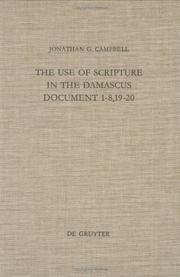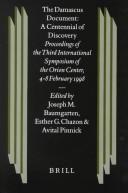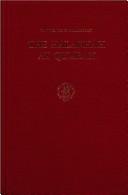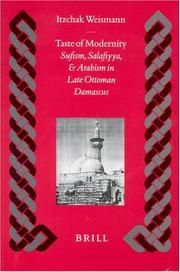| Listing 1 - 10 of 25 | << page >> |
Sort by
|
Multi
ISBN: 9781400853205 9780691616001 Year: 2014 Publisher: Princeton, N.J. Princeton University Press
Abstract | Keywords | Export | Availability | Bookmark
 Loading...
Loading...Choose an application
- Reference Manager
- EndNote
- RefWorks (Direct export to RefWorks)
History --- History of Asia --- anno 1700-1799 --- Damascus

ISBN: 3110142406 9783110875768 3110875764 9783110142402 Year: 1995 Volume: 228 Publisher: Berlin ; New York : W. de Gruyter,
Abstract | Keywords | Export | Availability | Bookmark
 Loading...
Loading...Choose an application
- Reference Manager
- EndNote
- RefWorks (Direct export to RefWorks)
In der Reihe Beihefte zur Zeitschrift für die alttestamentliche Wissenschaft (BZAW) erscheinen Arbeiten zu sämtlichen Gebieten der alttestamentlichen Wissenschaft. Im Zentrum steht die Hebräische Bibel, ihr Vor- und Nachleben im antiken Judentum sowie ihre vielfache Verzweigung in die benachbarten Kulturen der altorientalischen und hellenistisch-römischen Welt.
Qumran community --- Damascus document --- Damascus document. --- 229*316.1 --- Kumran community --- Jewish sects --- Essenes --- 229*316.1 Qumran-teksten: Damascusdocument; Gemeenteregel; Hôdayot/Hymnen; Oorlogsrol --- Qumran-teksten: Damascusdocument; Gemeenteregel; Hôdayot/Hymnen; Oorlogsrol --- Bible. --- Dead Sea scrolls. --- Zadokite documents --- Document of the new covenant in the land of Damascus --- Book of covenant of Damascus --- Damascus covenant --- Midrash on the eschatological Torah --- Midrash ha-Torah ha-aḥaron --- New Damascus document --- Antico Testamento --- Hebrew Bible --- Hebrew Scriptures --- Kitve-ḳodesh --- Miḳra --- Old Testament --- Palaia Diathēkē --- Pentateuch, Prophets, and Hagiographa --- Sean-Tiomna --- Stary Testament --- Tanakh --- Tawrāt --- Torah, Neviʼim, Ketuvim --- Torah, Neviʼim u-Khetuvim --- Velho Testamento --- Extra-canonical parallels. --- Theses --- Qumran community. --- Criticism, interpretation, etc.
Book
ISBN: 9789004464957 9789004470422 Year: 2022 Publisher: Leiden;Boston Brill
Abstract | Keywords | Export | Availability | Bookmark
 Loading...
Loading...Choose an application
- Reference Manager
- EndNote
- RefWorks (Direct export to RefWorks)
On 9 July 1860 CE, an outbreak of violence in the inner-city Christian quarter of Damascus created shock waves locally and internationally. This book provides a step-by-step presentation and reproduction of the facts to assess the true role of all the players and shapers of events. It critically examines the internal and external politico-socio-economic factors involved and argues that economic interests rather than religious fanaticism were the main causes for the riot of 1860. Furthermore, it argues that the riot was not a sudden eruption but rather a planned and organised affair.
Christianity and other religions --- Christianity. --- Christians --- Christians. --- Druzes --- Druzes. --- Ethnic relations. --- Interfaith relations. --- Islam --- Islam. --- Massacres --- Massacres. --- Religion. --- History --- Relations --- 1800-1899. --- Damascus (Syria) --- Lebanon --- Lebanon. --- Syria --- Turkey --- Turkey. --- History. --- Religion --- Ethnic relations --- Interfaith relations --- Damascus Riots, Damascus, Syria, 1860 --- Christianity --- Darazis --- Druse --- Druses --- Druz --- Druze --- Druzim --- Durūz --- Islamic sects --- Damascus Massacres, Damascus, Syria, 1860 --- Riots --- Religious adherents --- Mohammedanism --- Muhammadanism --- Muslimism --- Mussulmanism --- Religions --- Muslims --- Inter-ethnic relations --- Interethnic relations --- Relations among ethnic groups --- Acculturation --- Assimilation (Sociology) --- Ethnic groups --- Ethnology --- Social problems --- Sociology --- Minorities --- Race relations --- Dimashq (Syria) --- Dameśeḳ (Syria) --- Damascus --- Damas (Syria) --- Şam (Syria)

ISBN: 9004114629 9004350365 9789004114623 9789004350366 Year: 1999 Volume: 34 Publisher: Leiden ;Boston Brill
Abstract | Keywords | Export | Availability | Bookmark
 Loading...
Loading...Choose an application
- Reference Manager
- EndNote
- RefWorks (Direct export to RefWorks)
The papers published in this volume were presented at the Third International Orion Symposium (1998), to mark the centennial of the discovery of the Damascus Document (CD) in the Cairo Geniza and the final publication of the 4QD manuscripts in the Discoveries in the Judaean Desert series. Since its discovery, CD has sparked lively debate about its sectarian origins and halacha, issues with far-reaching implications not only for the development of Jewish law but also for the very nature of Second Temple period Judaism and its continuity into the early medieval period. The contributors examine the physical reconstruction of CD, its relationship to other legal works in the Qumran corpus and to rabbinic law. Essays on specific legal topics, as well as historical perspectives, round out the volume.
Damascus document --- Dead Sea scrolls --- 229*316.1 --- Qumran-teksten: Damascusdocument; Gemeenteregel; Hôdayot/Hymnen; Oorlogsrol --- 229*316.1 Qumran-teksten: Damascusdocument; Gemeenteregel; Hôdayot/Hymnen; Oorlogsrol --- Jerusalem scrolls --- ʻAin Fashka scrolls --- Jericho scrolls --- Scrolls, Dead Sea --- Qumrân scrolls --- Rękopisy z Qumran --- Shikai bunsho --- Megilot Midbar Yehudah --- Dodezee-rollen --- Kumránské rukopisy --- Documentos de Qumrán --- Textos de Qumrán --- Rollos del Mar Muerto --- Manuscritos del Mar Muerto --- Manuscrits de la mer Morte --- Dödahavsrullarna --- Kumranin kirjoitukset --- Kuolleenmeren kirjoitukset --- Qumranhandskrifterna --- Qumranin kirjoitukset --- Qumran Caves scrolls --- Zadokite documents --- Document of the new covenant in the land of Damascus --- Book of covenant of Damascus --- Damascus covenant --- Dead Sea scrolls. --- Midrash on the eschatological Torah --- Midrash ha-Torah ha-aḥaron --- New Damascus document --- Dead Sea Scrolls --- Criticism, interpretation, etc --- Congresses --- Damascus document - Congresses. --- Damascus document. --- Criticism, interpretation, etc. --- Hermeneutics.
Book
ISBN: 9654065754 9789654065757 9789654062152 9654062151 9789654062015 9789654062305 9654062011 9654062305 9654065711 9654065789 Year: 2007 Publisher: Jerusalem : Israel Antiquities Authority,
Abstract | Keywords | Export | Availability | Bookmark
 Loading...
Loading...Choose an application
- Reference Manager
- EndNote
- RefWorks (Direct export to RefWorks)
Excavations (Archaeology) --- Romans --- Fouilles (Archéologie) --- Romains --- Bāniyās (Damascus, Syria) --- Bāniyās (Damas, Syrie) --- Antiquities, Roman --- Antiquités romaines --- Bet Sheʼan (Israel) --- Beth Shéan (Israël) --- Antiquities, Roman. --- Archaeological digs --- Archaeological excavations --- Digs (Archaeology) --- Excavation sites (Archaeology) --- Ruins --- Sites, Excavation (Archaeology) --- Archaeology --- Ethnology --- Italic peoples --- Latini (Italic people) --- Bâniâs (Damascus, Syria) --- Bulunyas (Damascus, Syria) --- Bāniyās, Syria (Damascus) --- Architecture, Roman --- Beisān (Israel) --- Beith Shēan (Israel) --- Skythopolis (Israel) --- Besan (Israel) --- Bet Shan (Israel) --- Scythopolis (Israel) --- Beit Shean (Israel) --- Bethshean (Israel) --- Beth-Shan (Israel) --- Sḳitopolis (Israel) --- Tell el-Hosn (Israel) --- Tall al-Ḥusn (Israel) --- Baysān (Israel)

ISBN: 9004043489 9789004043480 9004667180 9789004667181 Year: 1975 Volume: v. 16 Publisher: Leiden ;Boston Brill
Abstract | Keywords | Export | Availability | Bookmark
 Loading...
Loading...Choose an application
- Reference Manager
- EndNote
- RefWorks (Direct export to RefWorks)
Jewish law --- Zadokite documents --- Sabbath (Jewish law) --- Droit juif --- Sabbat --- Dead Sea scrolls --- 229*316.2 --- Biblical law --- Civil law (Jewish law) --- Halacha --- Halakha --- Halakhah --- Hebrew law --- Jews --- Law, Hebrew --- Law, Jewish --- Law, Mosaic --- Law in the Bible --- Mosaic law --- Torah law --- Law, Semitic --- Commandments (Judaism) --- Qumran-secte en Essenen --- Law --- Jewish law. --- Dead Sea scrolls. --- Damascus document. --- 229*316.2 Qumran-secte en Essenen --- Sabbath (Jewish law). --- Jerusalem scrolls --- ʻAin Fashka scrolls --- Jericho scrolls --- Scrolls, Dead Sea --- Qumrân scrolls --- Rękopisy z Qumran --- Shikai bunsho --- Megilot Midbar Yehudah --- Dodezee-rollen --- Kumránské rukopisy --- Documentos de Qumrán --- Textos de Qumrán --- Rollos del Mar Muerto --- Manuscritos del Mar Muerto --- Manuscrits de la mer Morte --- Dödahavsrullarna --- Kumranin kirjoitukset --- Kuolleenmeren kirjoitukset --- Qumranhandskrifterna --- Qumranin kirjoitukset --- Qumran Caves scrolls --- Document of the new covenant in the land of Damascus --- Book of covenant of Damascus --- Damascus covenant --- Midrash on the eschatological Torah --- Midrash ha-Torah ha-aḥaron --- New Damascus document

ISBN: 9004119086 9786610464463 1417551879 1280464461 9047400615 9781417551873 9789047400615 9781280464461 6610464464 9789004119086 Year: 2001 Publisher: Leiden : Boston : Brill,
Abstract | Keywords | Export | Availability | Bookmark
 Loading...
Loading...Choose an application
- Reference Manager
- EndNote
- RefWorks (Direct export to RefWorks)
Modernization in the Muslim world was determined by the two interrelated processes of indigenous state formation and European economic penetration. This study traces the emergence of modern Islam and examines the relationship of Islamic modernization to the rise of Arab Nationalism.
Islam --- Salafīyah --- Sufism --- Sofism --- Mysticism --- Salafiyya --- Islamic sects --- Mohammedanism --- Muhammadanism --- Muslimism --- Mussulmanism --- Religions --- Muslims --- History --- History of Asia --- anno 1800-1899 --- anno 1900-1909 --- anno 1910-1919 --- Damascus --- History. --- Salafiyah
Book
ISBN: 0691052972 9781400853205 1400853206 9780691052977 9780691616001 0691643342 9780691643342 0691616000 9780691616001 1306989388 Year: 2014 Publisher: Princeton, NJ : Princeton University Press,
Abstract | Keywords | Export | Availability | Bookmark
 Loading...
Loading...Choose an application
- Reference Manager
- EndNote
- RefWorks (Direct export to RefWorks)
On the basis of new evidence from the Ottoman archives in Istanbul, Karl Barbir challenges the current interpretation of Ottoman rule in Damascus during the eighteenth century. He argues that the prevailing themes of decline and stagnation--usually applied to the entire century--in fact apply only to the latter half of the century. This discovery, he contends, affords a more balanced and realistic view of the Near East's Ottoman past than previous studies have suggested.Originally published in 1980.The Princeton Legacy Library uses the latest print-on-demand technology to again make available previously out-of-print books from the distinguished backlist of Princeton University Press. These editions preserve the original texts of these important books while presenting them in durable paperback and hardcover editions. The goal of the Princeton Legacy Library is to vastly increase access to the rich scholarly heritage found in the thousands of books published by Princeton University Press since its founding in 1905.
Muslim pilgrims and pilgrimages --- Islamic pilgrims and pilgrimages --- Pilgrims and pilgrimages, Muslim --- Muslim travelers --- Pilgrims and pilgrimages --- Syria --- Turkey --- Politics and government. --- Hadj --- Hajj --- Mecca, Pilgrimage to --- Pillars of Islam --- History of Asia --- anno 1700-1799 --- Damascus
Book
ISBN: 9789004311510 9004311513 900431489X 9789004314894 Year: 2016 Volume: 10 Publisher: Leiden, Netherlands ; Boston, [Massachusetts] : Brill,
Abstract | Keywords | Export | Availability | Bookmark
 Loading...
Loading...Choose an application
- Reference Manager
- EndNote
- RefWorks (Direct export to RefWorks)
In Die Rifāʽīya spürt Boris Liebrenz der Buchkultur des Osmanischen Syrien (16. - 19. Jahrhundert) durch den Fokus der einzig überlebenden Privatbibliothek der Epoche nach. Er fragt nach der Produktion und Transmission von Wissen sowie dem sozialen Hintergrund der Leserschaft im Zeitalter der Handschrift. Studien der arabischen Bibliotheksgeschichte haben oft nur das Mittelalter in den Blick genommen und basierten fast ausschließlich auf literarischen Quellen. Dies ist die erste Monographie, die eine einzige Region während der Osmanischen Periode in den Fokus nimmt und deren auf uns gekommene Handschriften und Notizen ihrer Leser und Besitzer systematisch als dokumentarische Quelle benutzt. So erhellt sie die materiellen, rechtlichen und sozialen Voraussetzungen von Buchbesitz und Lesepraxis. In Die Rifāʽīya Boris Liebrenz explores the book culture of Ottoman Syria (16th to 19th century), using the only surviving Damascene private library of the time as a vantage point. He asks about the production and transmission of knowledge as well as the social background of the reading audience in a manuscript age. Scholarship on Arabic libraries has often focussed on the medieval period and relied nearly exclusively on literary accounts. This is the first book-length study that focuses on a single region in the Ottoman period and systematically uses the vast number of surviving manuscripts as a documentary source by means of the notes left by their readers and possessors. Thus, it sheds light on the material, juridical, and social basis of book-ownership and reading.
Private libraries --- Manuscripts, Arabic --- Book industries and trade --- Books and reading --- Marginalia --- History. --- Universitätsbibliothek Leipzig --- Damascus (Syria) --- Intellectual life. --- History --- Bibliothek. --- Book industries and trade. --- Books and reading. --- Lesekultur. --- Manuscripts, Arabic. --- Marginalia. --- Private libraries. --- Universitätsbibliothek Leipzig --- Universitätsbibliothek Leipzig. --- Damaskus. --- Germany --- Islamic countries. --- Osmanisches Reich. --- Syria --- Syria. --- Arabic manuscripts --- Home libraries --- Libraries, Private --- Libraries --- Book collectors --- Leipzig. --- Bibliotheca Albertina --- Karl-Marx-Universität Leipzig. --- Leipziger Universitätsbibliothek --- Dimashq (Syria) --- Dameśeḳ (Syria) --- Damascus --- Damas (Syria) --- Şam (Syria)
Book
ISBN: 9789004413252 9004413251 900441326X 9789004413269 Year: 2020 Publisher: Leiden Boston : BRILL,
Abstract | Keywords | Export | Availability | Bookmark
 Loading...
Loading...Choose an application
- Reference Manager
- EndNote
- RefWorks (Direct export to RefWorks)
"In Damascus Life 1480-1500: A Report of a Local Notary Boaz Shoshan offers a microhistory of the largest Syrian city at the end of the Mamluk period and on the eve of the Ottoman conquest. Mainly based on a partly preserved diary, the earliest available of its kind and written by Ibn Ṭawq, a local notary, it portrays the life of a lower middle class who originated from the countryside and who, through marriage, was able to become a legal clerk and associate with scholars and bureaucrats. His diary does not only provide us with unique information on his family, social circle and the general situation in Damascus, but it also sheds light on subjects of which little is known, such as the functioning of the legal system, marriage and divorce, bourgeois property and the mores of the common people".
Arabs --- Notaries --- Notaries public --- Notary publics --- Justices of the peace --- Non-contentious jurisdiction --- Ethnology --- Semites --- Diaries --- Legal status, laws, etc. --- Ibn Ṭawq, Aḥmad ibn Muḥammad, --- Aḥmad ibn Muḥammad ibn Ṭawq, --- Aḥmad Ibn Ṭawq, --- إبن طوق، أحمد بن محمد --- Diaries. --- Damascus (Syria) --- Dimashq (Syria) --- Dameśeḳ (Syria) --- Damascus --- Damas (Syria) --- Şam (Syria) --- History --- Social conditions --- Social life and customs.
| Listing 1 - 10 of 25 | << page >> |
Sort by
|

 Search
Search Feedback
Feedback About UniCat
About UniCat  Help
Help News
News